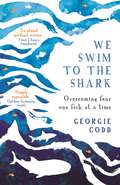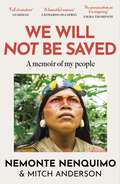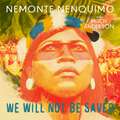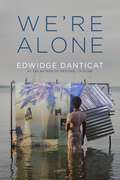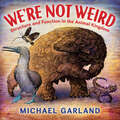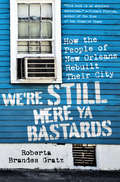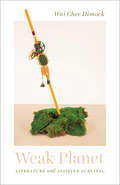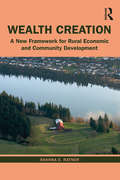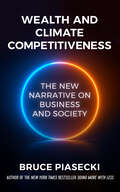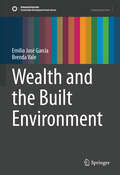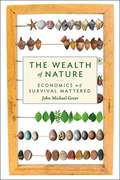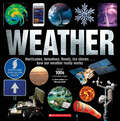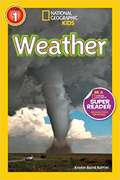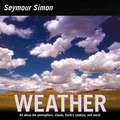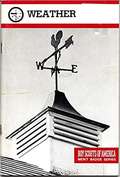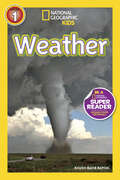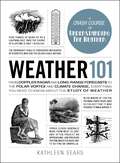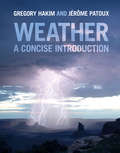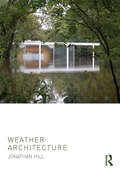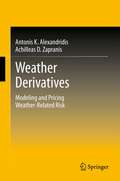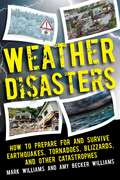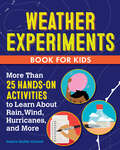- Table View
- List View
We Swim to the Shark: Overcoming fear one fish at a time
by Georgie CoddGeorgie Codd is scared of fish. Really, really scared.Loving the sea and resenting her phobia, she plots to cross continents, learn to dive and swim with the world's biggest fish: the mighty whale shark.Georgie soon plunges into a realm of strange creatures and intrepid diving adventurers. But as her quest to fight fear expands over oceans, the shark remains elusive, and everything else starts to fall apart around her.'We Swim to the Shark is a lesson in not giving up . . . as with all good adventure stories, the real benefit is in the searching' THE I'An almost spiritual mission' TIMES LITERARY SUPPLEMENT 'A terrific read' BBC RADIO NORFOLK 'An enthralling ride' ABC MELBOURNE
We Swim to the Shark: Overcoming fear one fish at a time
by Georgie CoddGeorgie Codd is scared of fish. Really, really scared.Loving the sea and resenting her phobia, she plots to cross continents, learn to dive and swim with the world's biggest fish: the mighty whale shark.Georgie soon plunges into a realm of strange creatures and intrepid diving adventurers. But as her quest to fight fear expands over oceans, the shark remains elusive, and everything else starts to fall apart around her.'We Swim to the Shark is a lesson in not giving up . . . as with all good adventure stories, the real benefit is in the searching' THE I'An almost spiritual mission' TIMES LITERARY SUPPLEMENT 'A terrific read' BBC RADIO NORFOLK 'An enthralling ride' ABC MELBOURNE
We Will Not Be Saved: A memoir of hope and resistance in the Amazon rainforest
by Nemonte Nenquimo'Nemonte's writing is as provocative as it is inspiring' EMMA THOMPSON'One of the most effective leaders for indigenous rights and environmental justice' LAURENE POWELL JOBS'I'm here to tell you my story, which is also the story of my people and the story of this forest.'Born into the Waorani tribe of Ecuador's Amazon rainforest, Nemonte Nenquimo was taught about plant medicines, foraging, oral storytelling, and shamanism by her elders. Age 14, she left the forest for the first time to study with an evangelical missionary group in the city. Eventually, her ancestors began appearing in her dreams, pleading with her to return and embrace her own culture.She listened. Two decades later, Nemonte has emerged as one of the most forceful voices in climate-change activism. She has spearheaded the alliance of indigenous nations across the Upper Amazon and led her people to a landmark victory against Big Oil, protecting over a half million acres of primary rainforest. Her message is as sharp as the spears that her ancestors wielded - honed by her experiences battling loggers, miners, oil companies and missionaries.In this astonishing memoir, she partners with her husband Mitch Anderson, founder of Amazon Frontlines, digging into generations of oral history, uprooting centuries of conquest, hacking away at racist notions of Indigenous peoples, and ultimately revealing a life story as rich, harsh and vital as the Amazon rainforest herself.More praise for We Will Not Be Saved: 'A radical manifesto for our times' VANESSA KIRBY'An act of storytelling generosity' NATHALIE KELLY'Inspiring, moving and unforgettable' ROWAN HOOPER'Truly Inspiring and humbling' CAROLINE SANDERSON** Publishing in the US as WE WILL BE JAGUARS**
We Will Not Be Saved: A memoir of hope and resistance in the Amazon rainforest
by Nemonte Nenquimo** Publishing in the US as WE WILL BE JAGUARS**'I'm here to tell you my story, which is also the story of my people and the story of this forest.'Born into the Waorani tribe of Ecuador's Amazon rainforest, Nemonte Nenquimo was taught about plant medicines, foraging, oral storytelling, and shamanism by her elders. Age 14, she left the forest for the first time to study with an evangelical missionary group in the city. Eventually, her ancestors began appearing in her dreams, pleading with her to return and embrace her own culture.She listened. Two decades later, Nemonte has emerged as one of the most forceful voices in climate-change activism. She has spearheaded the alliance of indigenous nations across the Upper Amazon and led her people to a landmark victory against Big Oil, protecting over a half million acres of primary rainforest. Her message is as sharp as the spears that her ancestors wielded - honed by her experiences battling loggers, miners, oil companies and missionaries.In this astonishing memoir, she partners with her husband Mitch Anderson, founder of Amazon Frontlines, digging into generations of oral history, uprooting centuries of conquest, hacking away at racist notions of Indigenous peoples, and ultimately revealing a life story as rich, harsh and vital as the Amazon rainforest herself.The Waorani language (referred to as Wao Tededo in the audiobook) is one of the world's most endangered languages and is only spoken by around 2,000 people. The Publishers would like to thank Oswando Nenquimo (Opi) and Connie Dickinson as well as the Endangered Languages Archive https://www.elararchive.org/ and the Endangered Languages Documentation Program https://www.eldp.net/ for their valuable support in ensuring accurate pronunciation of Waorani names and terms.
We're Alone: Essays
by Edwidge DanticatA collection of exceptional new essays by one of the most significant contemporary writers on the world stage Tracing a loose arc from Edwidge Danticat’s childhood to the COVID-19 pandemic and recent events in Haiti, the essays gathered in We’re Alone include personal narrative, reportage, and tributes to mentors and heroes such as Toni Morrison, Paule Marshall, Gabriel García Márquez, and James Baldwin that explore several abiding themes: environmental catastrophe, the traumas of colonialism, motherhood, and the complexities of resilience.From hurricanes to political violence, from her days as a new student at a Brooklyn elementary school knowing little English to her account of a shooting hoax at a Miami mall, Danticat has an extraordinary ability to move from the personal to the global and back again. Throughout, literature and art prove to be her reliable companions and guides in both tragedies and triumphs.Danticat is an irresistible presence on the page: full of heart, outrage, humor, clear thinking, and moral questioning, while reminding us of the possibilities of community. And so “we’re alone” is both a fearsome admission and an intimate invitation—we’re alone now, we can talk. We’re Alone is a book that asks us to think through some of the world’s intractable problems while deepening our understanding of one of the most significant novelists at work today.
We're Not Weird: Structure and Function in the Animal Kingdom
by Michael GarlandMeet nature&’s most extraordinary looking creatures. But they aren&’t weird!Birds with blue feet, fish that walk, unicorns in the sea, and more! Learn how these animals' quirks help them survive. Perfect for budding naturalists who are always ready to share a cool (or gross) animal fact. Very hard scales protect me, and my long tongue is perfect for eating ants. When I feel threatened, I roll myself into a ball. I am a Pangolin.See these animals&’ amazing body parts in vibrant and detailed woodcut illustrations, from the thorny dragon&’s spiky skin to the star-nosed mole's twenty-two feelers. Read how these creatures' unique traits help them thrive and survive in their environments. Learn where they live, what they eat, how they protect themselves, and more. With easy-to-read text vetted by an expert, this book aligns with the Next Generation Science Standards on adaptation, structure, and function for kindergarten through 3rd grade. With supplementary information on each animal&’s habitat and diet.
We're Still Here Ya Bastards: How the People of New Orleans Rebuilt Their City
by Roberta Brandes GratzThe aftermath of Hurricane Katrina is one of the darkest chapters is American history. A toxic combination of government neglect and socioeconomic inequality turned a crisis into a tragedy. The storm completely transformed one of the most beloved cities in America, leaving nearly 80 percent of New Orleans flooded and damaging 134,000 housing units, causing unprecedented destruction. The response to Katrina is a topic of unending debate and anger. But out of the rubble, there is hope. Watching coverage of the hurricane on television in 2005, noted urbanist and veteran journalist Roberta Brandes Gratz knew that the best chance for the city's recovery came from the people who would return to New Orleans. She also knew that she wanted to see for herself how the city would respond. Two years later, after having made several trips to the area and written several articles, Gratz bought a house in the Bywater neighborhood of New Orleans and immersed herself in the life of the city. We’re Still Here Ya Bastards presents an unprecedented panoramic look at New Orleans’ recovery in the years following the hurricane. From the Lower Ninth Ward to the storied French Quarter, Gratz shares the stories of people who returned to their homes and have taken the rebuilding of their city into their own hands. An internationally renowned urban critic, Gratz shows how the city is recovering despite erroneous governmental policies that serve private interests rather than the public good. By telling stories that are often ignored by the mainstream media, We’re Still Here Ya Bastards shows the strength and resilience of a community that continues to work to rebuild New Orleans.
Weak Planet: Literature and Assisted Survival
by Wai Chee Dimock“Exploring weakness and vulnerability from the origins of American literature to the present, she provocatively argues for ‘collateral resilience.’” —Viet Thanh Nguyen, Pulitzer Prize–winning authorVulnerability. We see it everywhere. In once permanent institutions. In runaway pandemics. In democracy itself. And most frighteningly, in ecosystems with no sustainable future. Against these large-scale hazards of climate change, what can literature teach us? This is the question Wai Chee Dimock asks in Weak Planet, proposing a way forward, inspired by works that survive through kinship with strangers and with the nonhuman world.Drawing on Native American studies, disability studies, and environmental humanities, Dimock shows how hope can be found not in heroic statements but in incremental and unspectacular teamwork. Reversing the usual focus on hegemonic institutions, she highlights instead incomplete gestures given an afterlife with the help of others. She looks at Louise Erdrich’s and Sherman Alexie’s user-amended captivity narratives; nontragic sequels to Moby-Dick by C. L. R. James, Frank Stella, and Amitav Ghosh; induced forms of Irishness in Henry James, Colm Tóibín, W. B. Yeats, and Gish Jen; and the experimentations afforded by a blurry Islam in works by Henri Matisse, James Joyce, Ezra Pound, and Langston Hughes. Celebrating literature’s durability as an assisted outcome, Weak Planet gives us new ways to think about our collective future.“Weak Planet invites us to reflect on the deep interconnections between two threatened extinctions: that of the humanities and that of a host of animal species (not least our own). The book is nothing short of a radical reorientation of literary history.” —Stephen Best, author of None Like Us: Blackness, Belonging, Aesthetic Life
Wealth Creation: A New Framework for Rural Economic and Community Development
by Shanna E. RatnerA new approach to rural development is emerging. Instead of being about attracting companies that might create jobs over which communities have no control, the emerging paradigm is about connecting the unique underutilized assets of place with market opportunity to grow assets that are owned and controlled by and for the benefit of low-wealth people and places. But asset development is about more than bricks and mortar or narrowly defined financial assets. There are many kinds of assets that communities require to thrive – such as social capital, natural capital, political capital, and intellectual capital. The emerging new approach to rural development is, then about broadening the definition of "wealth," engaging underutilized assets, and a key third element: harnessing the power of the market – rather than relying solely on philanthropy and government. Wealth Creation provides a conceptual guide with practical examples for policymakers, practitioners of economic and community development, community organizers, environmentalists, funders, investors, and corporations seeking a values-based framework for identifying self-interests across sectors that can lead to opportunities to transform existing systems for the collective good.
Wealth and Climate Competitiveness: The New Narrative on Business and Society
by Bruce PiaseckiA new book from New York Times bestselling author Bruce Piasecki, Wealth and Climate Competitiveness explores how wealth, both private and corporate, can assist the path to climate competitiveness. Many of the central concerns of the twenty-first century—racial inequity, white supremacy movements, greater inclusiveness of diverse peoples—are rooted in facing and overcoming prejudices, both common and hidden. Another great challenge—the role of wealth and innovation in solving the climate crisis—is also riddled with disabling prejudices about how corporations work, and about the rights and needs of consumers and world citizens. In his twenty-first book, Wealth and Climate Competitiveness: The New Narrative on Business and Society, Bruce Piasecki argues that a set of five recurring prejudices, from 1900 to 2020, have held up real progress on climate action. Using the examples of select firms like Trane Technologies, and oil giants like the transforming bp, Piasecki sets out to define climate competitiveness as a path to solutions that decarbonize, decentralize, and digitize our near future. Climate competitiveness involves a responsible, steady, resolve-based focus on lessons derived from human behavior and social movements. By using Robin Hood as a narrative example, this book is designed to give you a deep understanding of the changed landscape we now face, and how you can resolve to embrace climate competitiveness to drive your personal success, and the corporate and institutional success of our world.
Wealth and the Built Environment (Sustainable Development Goals Series)
by Brenda Vale Emilio José GarcíaThe need to address global environmental problems is urgent. The United Nations 17 Sustainable Development Goals (SDGs) cover a wide range of global concerns, from poverty, hunger, and gender equity to justice and climate action. Concerningly, the SDGs still have faith in economic growth and technological innovation as the means of fixing all global concerns, including climate change. What is not questioned is whether solving development and sustainability problems through economic growth for the accumulation of wealth for the few has led to many of the current unequal development and environmental problems. If unfair growth and wealth accumulation have been part of the problem, how can they be part of the solution? The problem with the SDGs is that their fulfilment relies on wealth creation without the fundamental concomitant of wealth redistribution. The one common driver of change affecting both sustainability and development that has not been included in the SDGs is wealth, the central focus of this book. SDG 11 – sustainable cities and communities – presents a further paradox unless the issue of wealth and its fair distribution is grasped. Cities are the places where wealth is generated but are also places where only a minority are wealthy. The wealth generated in cities leads to higher consumption of resources, higher emissions, and higher disparities and inequalities. However, any version of a sustainable future will happen in the built environment made according to current ideals, like the present belief in overcoming all humanity's problems by becoming wealthier. A fundamental assumption of this book is that the first step toward a fairer habitat that can maintained with the resources available is only possible if we stop designing cities and buildings as if everyone were wealthy or had to become wealthy. To achieve this goal, it is essential to identify and raise awareness of the impact of wealth, to question how the myths about the advantages of wealth were built, where they come from, what shape they take in the built environment and who benefits from them.
Wealth of Nature: Economics as if Survival Mattered
by John Michael GreerJohn Michael Greer has re-thought economics, starting from its fundamental premises, giving it a basis in ecological reality rather than political fiction. The result is perhaps the most important and readable book on economics since Small Is Beautiful. Richard Heinberg, author of The End of Growth.
Weather
by John Farndon Sean Callery Miranda SmithFrom wild tornadoes to blinding blizzards, learn what makes our climate and weather work in this stunning visual guide.Fiercer hurricanes, hungrier wildfires, flash floods, and desertification are becoming a part of daily life as our climate shifts and changes. Weather covers the most important areas of this timely topic, delivering up-to-date expert information on everything from the water cycle to winds, cloud galleries, fog, and snow, and from extreme weather like hurricanes, supercell tornadoes, firestorms, and dust storms to the people who predict them and try to save others.Beautifully laid out images of weather objects and processes using satellite imagery, time-lapse photography, and eyewitness reportage put readers in the eye of the storm for close-up learning. A must-read for curious young scientists interested in the weather systems that shape our world.
Weather
by Kristin Baird RattiniExplores the causes of everyday weather phenomena, including how clouds form, why tornadoes twist, and how the sun helps life grow.
Weather
by Seymour SimonEver wonder what makes the wind blow? Or where clouds come from, or rain? Every day you experience weather, but why do you experience the weather you do?<P><P> Explore weather, a subject that changes every day, with award-winning science writer Seymour Simon.
Weather (Merit Badge Series)
by Boy Scouts of AmericaThis book introduces scouts to the science of weather.
Weather (National Geographic Readers)
by Kristin Baird RattiniNIMAC-sourced textbook <P><P>What causes thunder and lightning? How do different clouds form? What makes a tornado twist? Kids will discover the answers to these questions and more in this colorful, photo-packed book. In this inviting and entertaining format, kids will discover what causes the weather they experience every day. This level 1 reader is written in an easy-to-grasp style to encourage the meteorologists of tomorrow!
Weather (Readers)
by Kristin Baird RattiniWhat causes thunder and lightning? How do different clouds form? What makes a tornado twist? Kids will discover the answers to these questons and more in this colorful, photo-packed book. In this inviting and entertaining format, kids will discover what causes the weather they experience every day. This Level 1 reader is written in an easy-to-grasp style to encourage the meteorologists of tomorrow!
Weather 101: From Doppler Radar and Long-Range Forecasts to the Polar Vortex and Climate Change, Everything You Need to Know about the Study of Weather (Adams 101 Series)
by Kathleen SearsIn this clear and straight new guide from the author of Grammar 101 and Weather 101, get a crash course in understanding the science behind weather and weather prediction.Weather is everywhere, and while it&’s typically not thought about most of the time, it can get everyone&’s attention in an instant—whether it&’s the swirling destruction of a tornado, the wreckage from a hurricane, or the havoc of climate change on the environment. Weather 101 gives you the basics on weather, from blue skies to hail to dust storms, with information on the science of how weather works, how to predict the weather in your area, how to be ready for natural disasters, and how climate change is affecting weather patterns across the world. With this guide, you&’ll be a weather expert in no time!
Weather A Concise Introduction
by Gregory Hakim J賴me PatouxFrom a world-renowned team at the Department of Atmospheric Sciences at the University of Washington, Seattle, Weather: A Concise Introduction is an accessible and beautifully illustrated text covering the foundations of meteorology in a concise, clear, and engaging manner. Designed to provide students with a strong foundation in the physical, dynamical, and chemical processes taking place in the atmosphere, this introductory textbook will appeal to students with a wide range of mathematical and scientific backgrounds. This textbook features: a single case study of a mid-latitude cyclone which is referred to throughout the whole book to illustrate the basic principles driving atmospheric dynamics and phenomena; boxes on more advanced topics; appendices for additional coverage; chapter summaries listing the 'take-home' points discussed; and colour figures and charts illustrating the fundamental concepts. Key terms are evident throughout, and a glossary explains the terms that students will need to understand and become familiar with.
Weather And Climate
by Winston Staff Rinehart HoltExploring, inventing, and investigating are essential to the study of science. However, these activities can also be dangerous. To make sure that your experiments and explorations are safe, you must be aware of a variety of safety guidelines.
Weather Architecture
by Jonathan HillWeather Architecture further extends Jonathan Hill’s investigation of authorship by recognising the creativity of the weather. At a time when environmental awareness is of growing relevance, the overriding aim is to understand a history of architecture as a history of weather and thus to consider the weather as an architectural author that affects design, construction and use in a creative dialogue with other authors such as the architect and user. Environmental discussions in architecture tend to focus on the practical or the poetic but here they are considered together. Rather than investigate architecture’s relations to the weather in isolation, they are integrated into a wider discussion of cultural and social influences on architecture. The analysis of weather’s effects on the design and experience of specific buildings and gardens is interwoven with a historical survey of changing attitudes to the weather in the arts, sciences and society, leading to a critical re-evaluation of contemporary responses to climate change.
Weather Derivatives
by Achilleas D. Zapranis Antonis Alexandridis K.Weather derivatives are financial instruments that can be used by organizations or individuals as part of a risk management strategy to minimize risk associated with adverse or unexpected weather conditions. Just as traditional contingent claims, a weather derivative has an underlying measure, such as: rainfall, wind, snow or temperature. Nearly $1 trillion of the U.S. economy is directly exposed to weather-related risk. More precisely, almost 30% of the U.S. economy and 70% of U.S. companies are affected by weather. The purpose of this monograph is to conduct an in-depth analysis of financial products that are traded in the weather market. Presenting a pricing and modeling approach for weather derivatives written on various underlying weather variables will help students, researchers, and industry professionals accurately price weather derivatives, and will provide strategies for effectively hedging against weather-related risk. This book will link the mathematical aspects of the modeling procedure of weather variables to the financial markets and the pricing of weather derivatives. Very little has been published in the area of weather risk, and this volume will appeal to graduate-level students and researchers studying financial mathematics, risk management, or energy finance, in addition to investors and professionals within the financial services industry.
Weather Disasters: How to Prepare For and Survive Earthquakes, Tornadoes, Blizzards, and Other Catastrophes
by Mark D. Williams Amy Becker WilliamsFloods. Blizzards. Landslides. Earthquakes. Tornadoes. Hurricanes. Severe weather happens every day across the globe. We see and hear of the devastating consequences whenever we tune into the evening news: property ravaged, communities destroyed, and lives lost. But although these events are unstoppable, you can prepare. In Weather Disasters, veteran authors and disaster survivors Mark and Amy Williams provide vital information on prepping for and surviving every major type of weather disaster. Each chapter is devoted to a different catastrophe, and lists: The science behind the catastrophe Essentials you’ll need to get through it Helpful prepping tips Statistics behind the disaster Resources to reach out to for help What to do in the aftermath No matter who you are or where you live, catastrophe can strike at any time. Be prepared, and pick up Weather Disasters today!
Weather Experiments Book for Kids: More Than 25 Hands-On Activities to Learn about Rain, Wind, Hurricanes, and More
by Jessica Stoller-ConradHelp kids ages 8 to 12 experiment like scientists and discover the world of weather! What makes the weather change? What happens in the sky when storm clouds form? The Weather Experiments Book for Kids does more than just explain how weather events work—it lets kids see weather in action! Discover 25 fun experiments kids can create right at home, and explore fascinating weather like rain, clouds, tornadoes, and more! What's weather, anyway?—Kids will get a quick introduction to the difference between weather, climate, and atmosphere, and all the factors that affect what it looks like outside each day. Get hands-on—Kids will make their own barometer that measures atmospheric pressure, create clouds with water and hairspray, test soil conditions, and more. Independent learning—These experiments are designed with easy instructions and materials so kids can do them with minimal help from adults. Discover more than other weather books for kids with experiments that make weather come to life!
